Featured Comment
I made this again and can’t believe how good it is.
★★★★★
– @Gaff
Ever feared you’d mess up miso soup by stirring the paste wrong? As a Japanese I’ve made all kinds of authentic miso soup recipes. Classic tofu and wakame miso soup, tonjiru, salmon miso soup, torijiru, clam miso soup, even vegan ginger miso soup. Each has its charm.
But this mushroom version delivers fall comfort and rich umami the fastest. Let’s make it tonight.
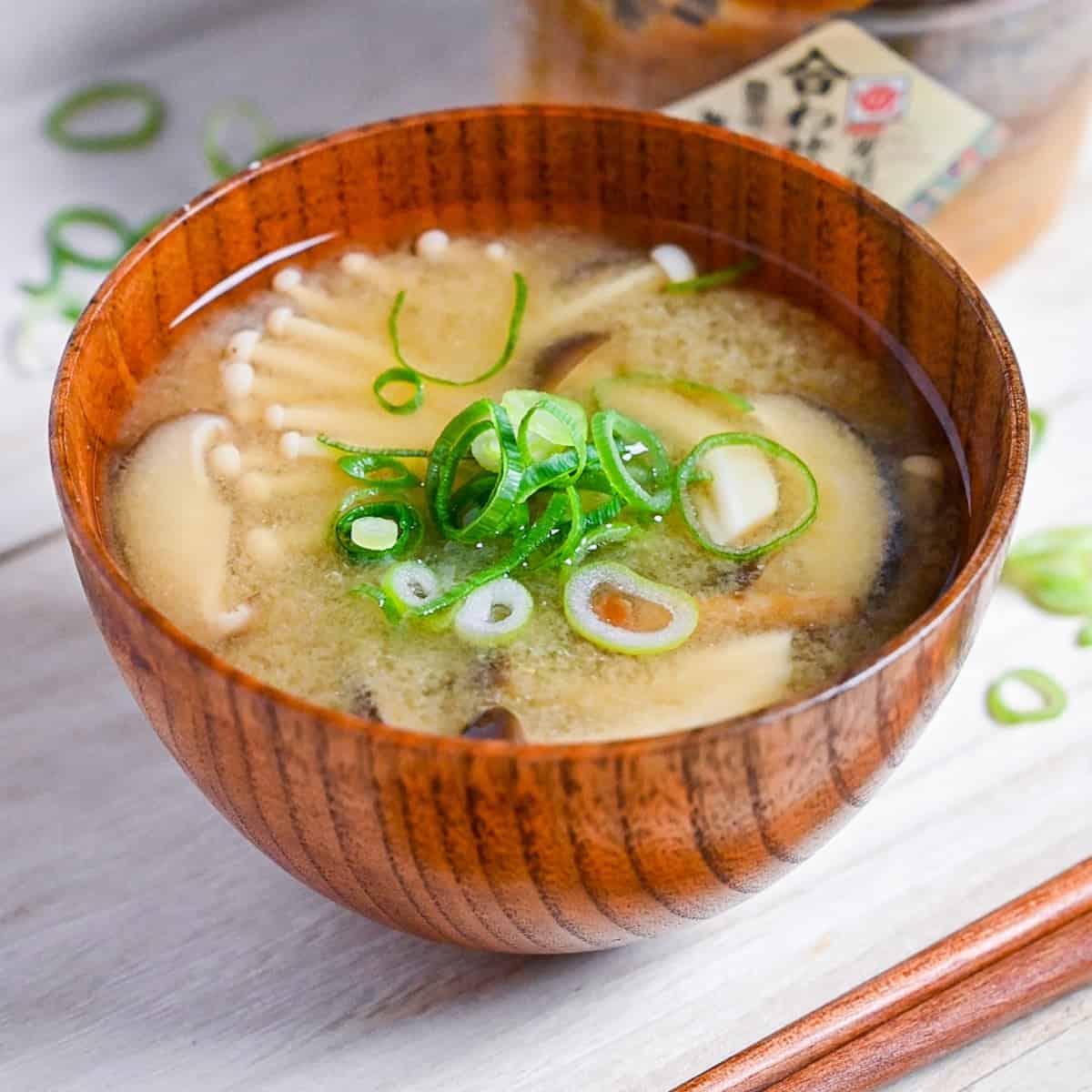
Mushroom Miso Soup
Recipe Snapshot
- What is it? Lightning fast umami-rich mushroom miso soup.
- Flavor profile: Savory, Delicate, Earthy
- Why you’ll love this recipe: This soup delivers deep, restaurant-style umami in just 20 minutes.
- Must-haves: Yellow miso paste (awase miso), Dashi stock (shiitake + kombu for plant-based), Your favorite mushrooms.
- Skill Level: Easy
- Suitable for Meal Prep? Partially.
Summarize & Save this content on:
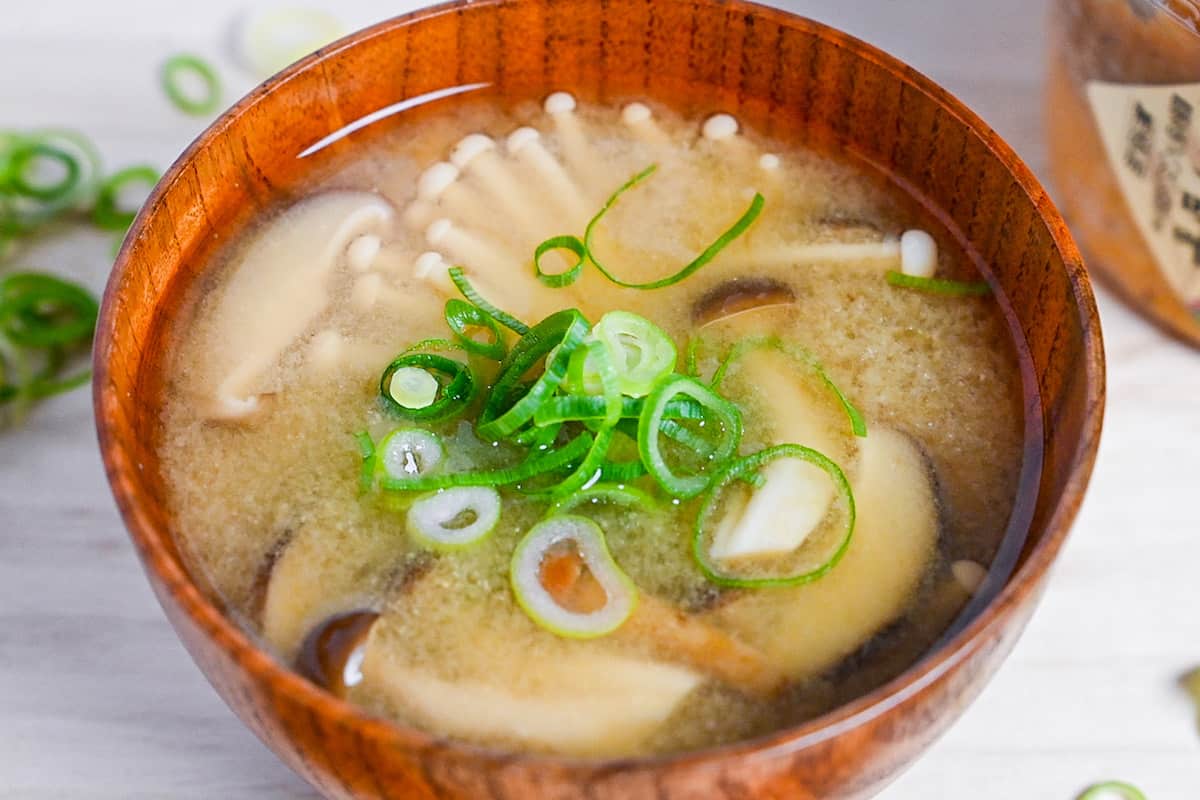
What is Mushroom Miso Soup?
Miso soup (味噌汁) is one of the most essential dishes in Japanese cuisine. This simple blend of miso paste whisked into dashi stock is steeped in tradition and culture, but what makes it really special is the endless flexibility. With different add-ins that vary from family to family, and region to region, this simple base transforms into something unique and personal.
Mushroom miso soup is a cozy version that leans on the earthy depth of mushrooms. They create a broth that’s comforting but light, perfect for weeknights. If you’re cooking plant-based, you can build the base with vegan dashi, which keeps the flavor deep without using fish.
For a fuller mushroom feast using the same ingredients, try pairing this soup with crispy enoki mushrooms, mushroom rice bowl, or even Cheesy enoki mushroom snacks!
Mushroom Miso Soup Ingredients
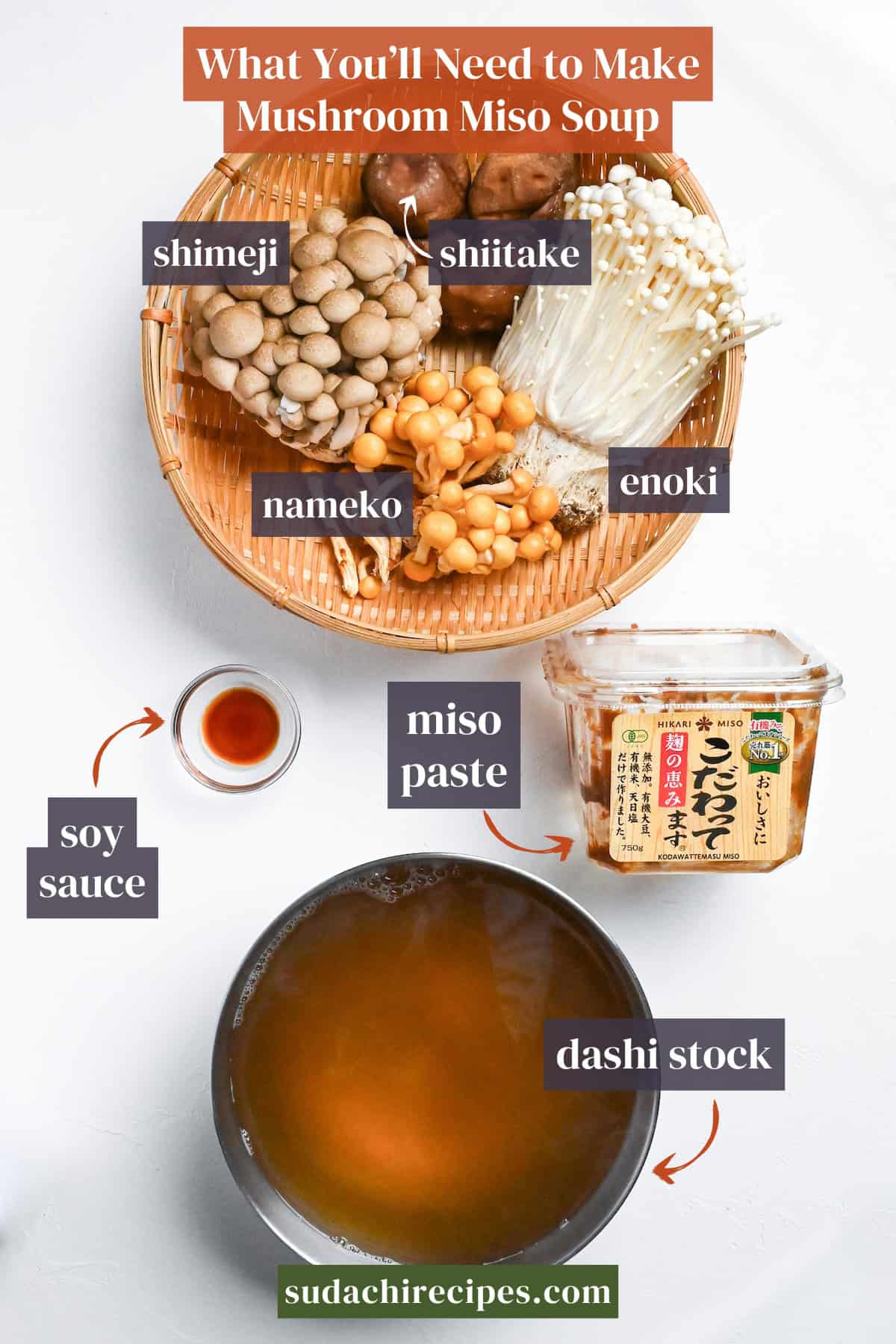
- Yellow miso paste (awase): This is a blend of white and red miso, so it tastes balanced. You can pick it up at Asian groceries, or in the miso section at regular supermarkets and major online retailers. If you want to make miso soup with red miso, check out my akadashi recipe.
- Mushrooms: My mix are shimeji (beech), enoki, shiitake, and nameko. Enoki and shimeji are easy finds at Asian markets. Nameko shows up fresh at Japanese grocers or as jarred/dried “nameko in water” online. Use any local combo you can grab, cremini + oyster/king oyster keep a Japanese feel.
- Japanese soy sauce (koikuchi shoyu): A tiny splash of this classic dark, well-rounded shoyu deepens the broth with a toasty, savory finish, but you can skip this entirely if you don’t have it.
Substitution Ideas
- Plant-based: Swap regular dashi for vegan dashi (dried mushrooms + kombu). Many Asian stores sell pre-made vegetarian dashi packets that work perfectly here.
- Gluten-free: Skip the soy sauce entirely and choose certified GF miso paste.
- Mushroom swaps: Can’t find Japanese varieties? Use any combination of cremini, oyster, king oyster, pioppino, chestnut, or hen of the woods. Any of your favorite local mushrooms!
Have trouble finding Japanese ingredients? Check out my ultimate guide to Japanese ingredient substitutes!
How to Make My Mushroom Miso Soup
Before you start: Trim or cut the mushrooms according to type so they cook evenly and taste clean.
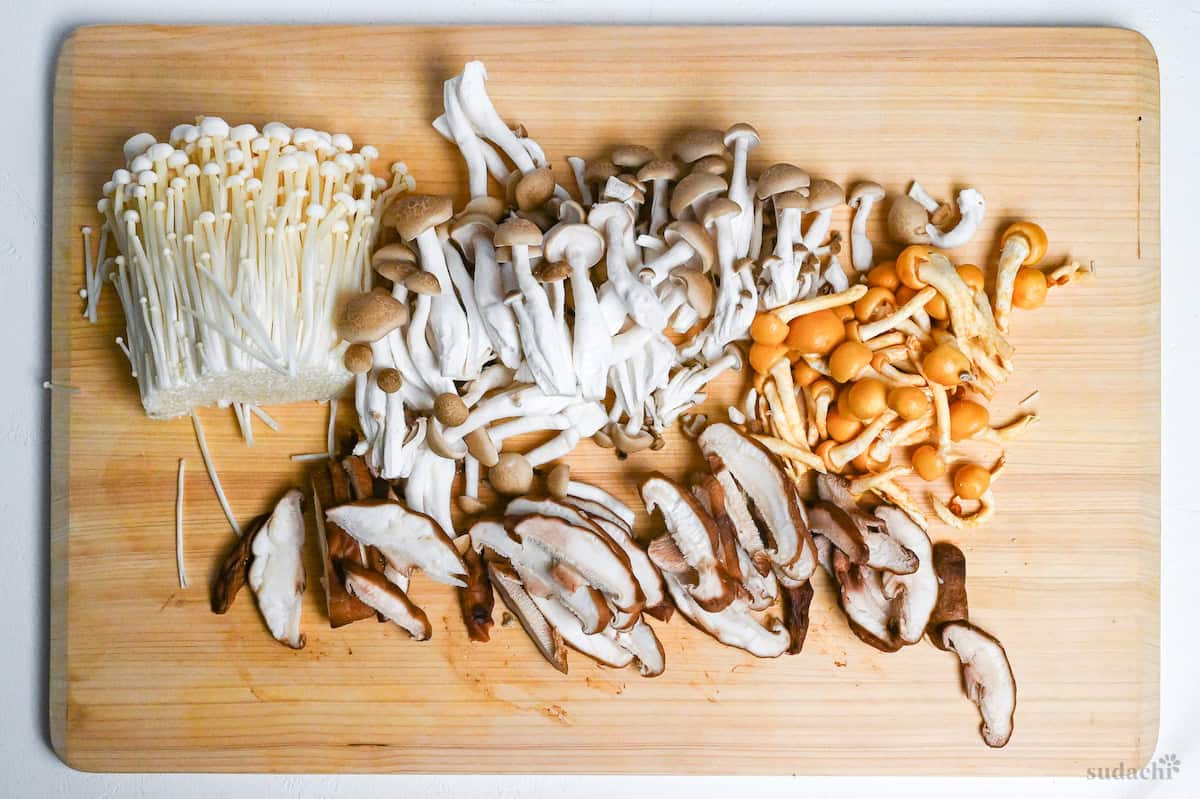
If you prefer to watch the process in action, check out my YouTube video of this mushroom miso soup recipe!
i. Pour dashi into a pot and bring it to just below a boil, aiming for gentle movement, not a rolling boil, around 90-95℃ (194-203°F). This keeps the broth clear and prevents kombu or bonito from turning bitter or murky.
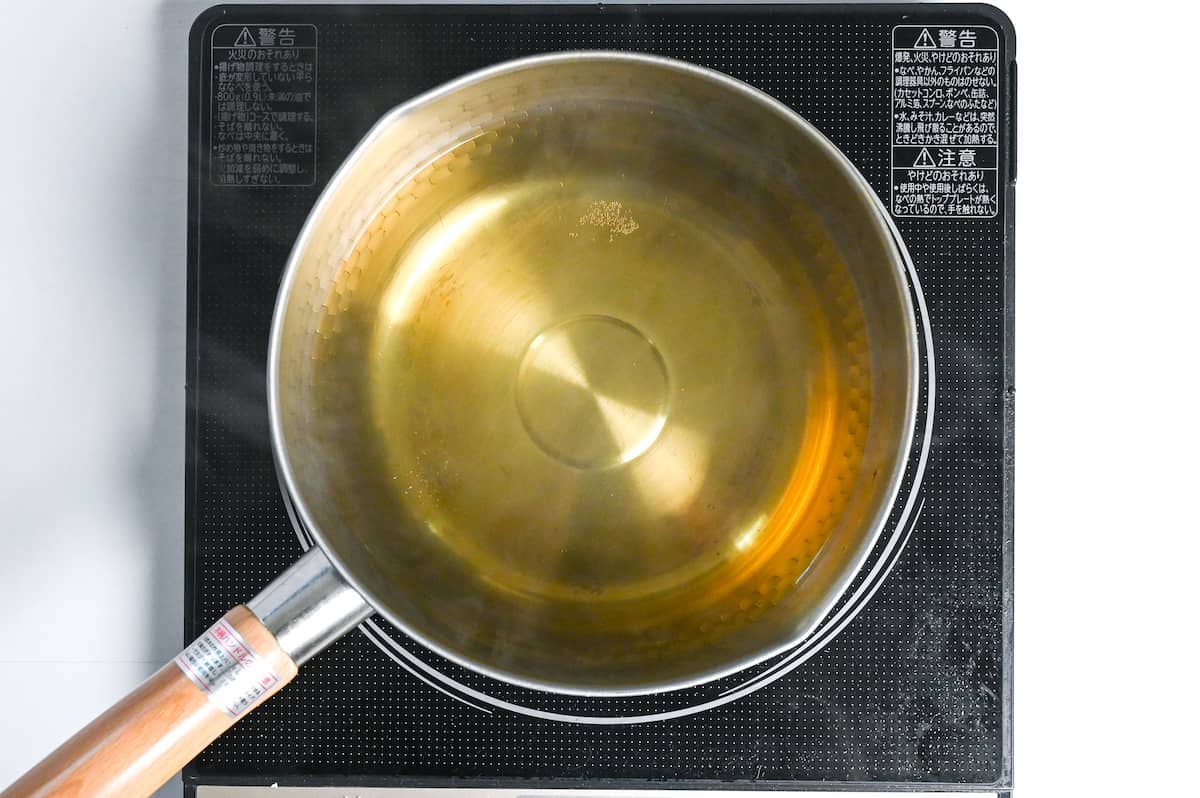
For classic awase dashi, use kombu + katsuobushi. For a fully plant-based version, make shōjin dashi with kombu + dried shiitake. Both are fast and deliver deep umami. Choose based on your diners.
If you’re in hurry, dashi packet is the best alternative to homemade. Instant dashi granules are the last resort.
ii. Once the dashi is nearly boiling, season with soy sauce to round the umami. If you’re cooking gluten-free, swap in gluten-free tamari. If you prefer a lighter sodium profile, hold back here and let the miso carry the seasoning.
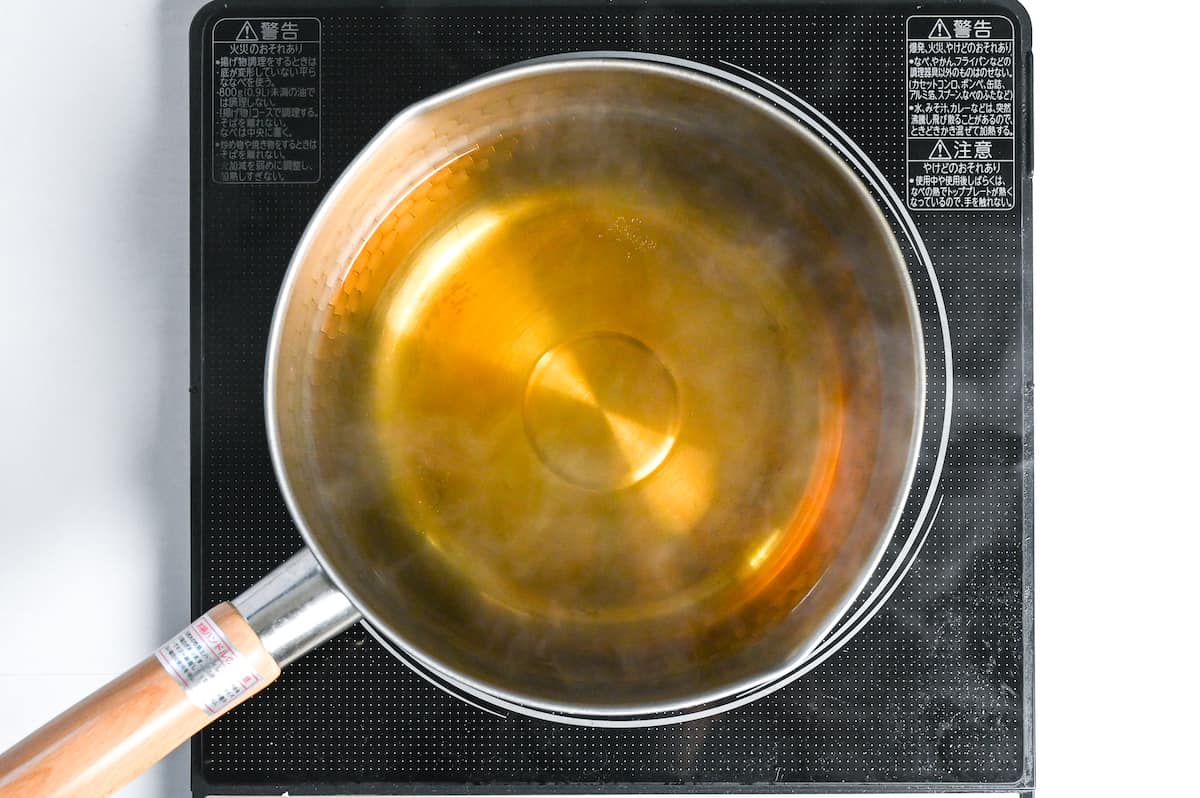
i. Add the prepared mushrooms and return the broth to a gentle simmer at 85-90℃ (185-194°F). Cook 3-4 minutes, until shiitake edges look supple and enoki/shimeji turn silky.
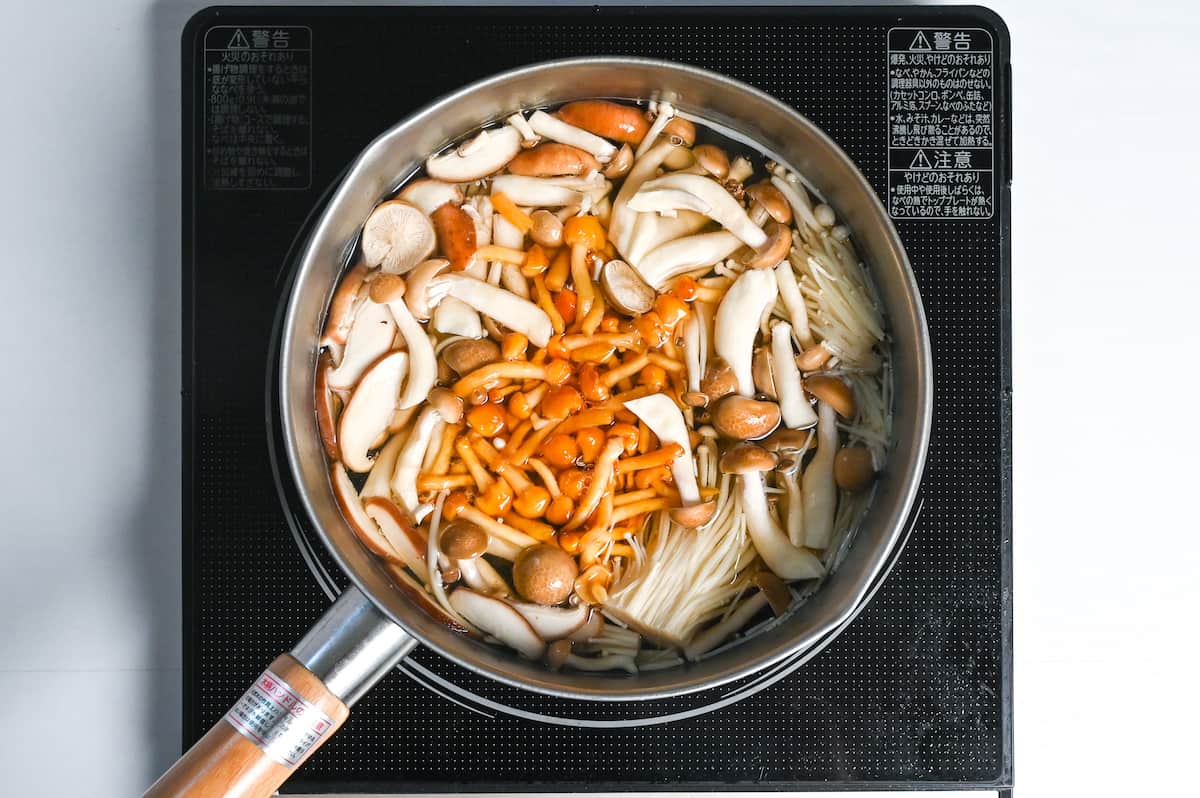
Large mushrooms like shiitake should be thinly sliced so they soften at the same pace as smaller varieties. Tiny clusters (enoki/shimeji) can be left whole after trimming. This prevents rubbery bites and uneven doneness.
i. Turn off the heat. Measure miso into a mesh ladle or strainer, dip it into the hot broth, and whisk or press it through so it dissolves smoothly without lumps. If miso escapes in clumps, just keep stirring through the strainer until the last bits dissolve.
If you don’t have a mesh ladle like below, place the miso in a small heatproof bowl and add 1-2 tbsp of the hot broth. Whisk it into a smooth pourable paste before adding it to the pot.
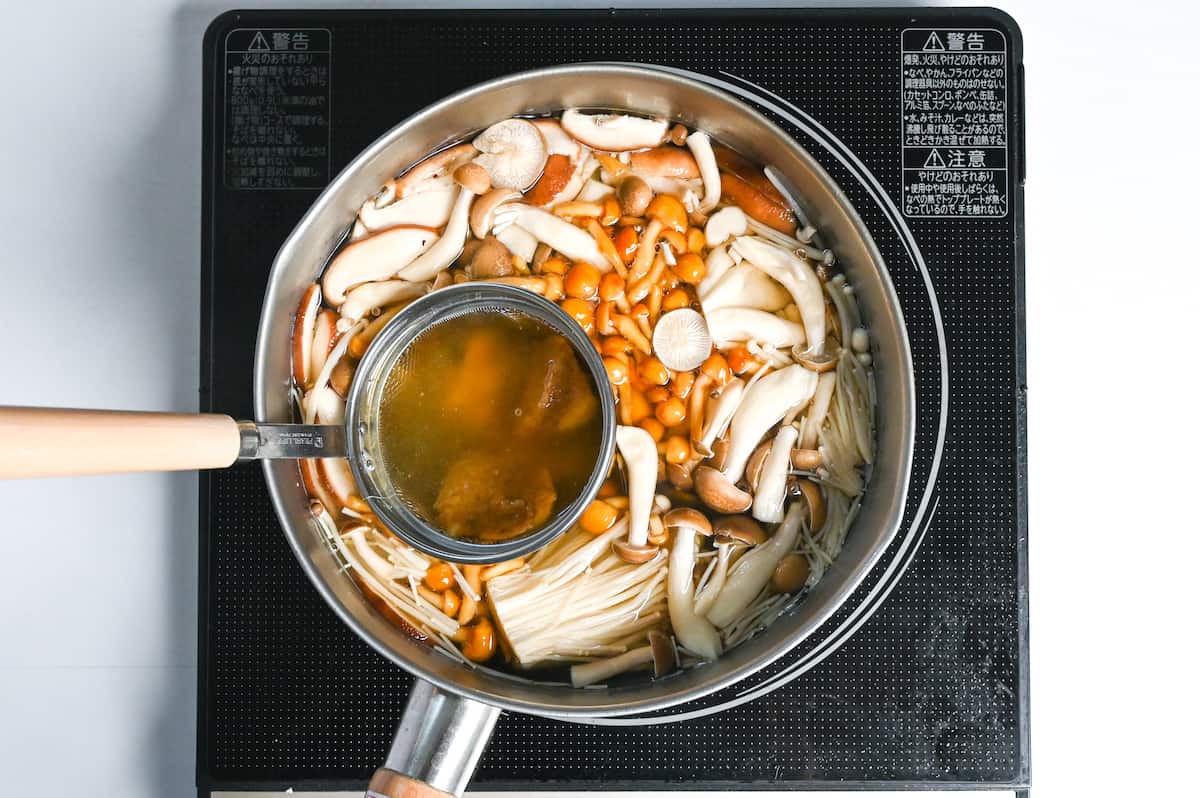
Boiling after miso is added mutes aroma and can destroy heat-sensitive enzymes and live cultures in unpasteurized miso; adding it off heat preserves flavor complexity. Keep the soup below a simmer once miso is in.
ii. Stir the pot to redistribute the miso, then ladle into bowls. Garnish with chopped green onions for freshness and a little bite. Serve immediately so the miso doesn’t settle. If it does settle as you serve, give each bowl a quick swirl with chopsticks.
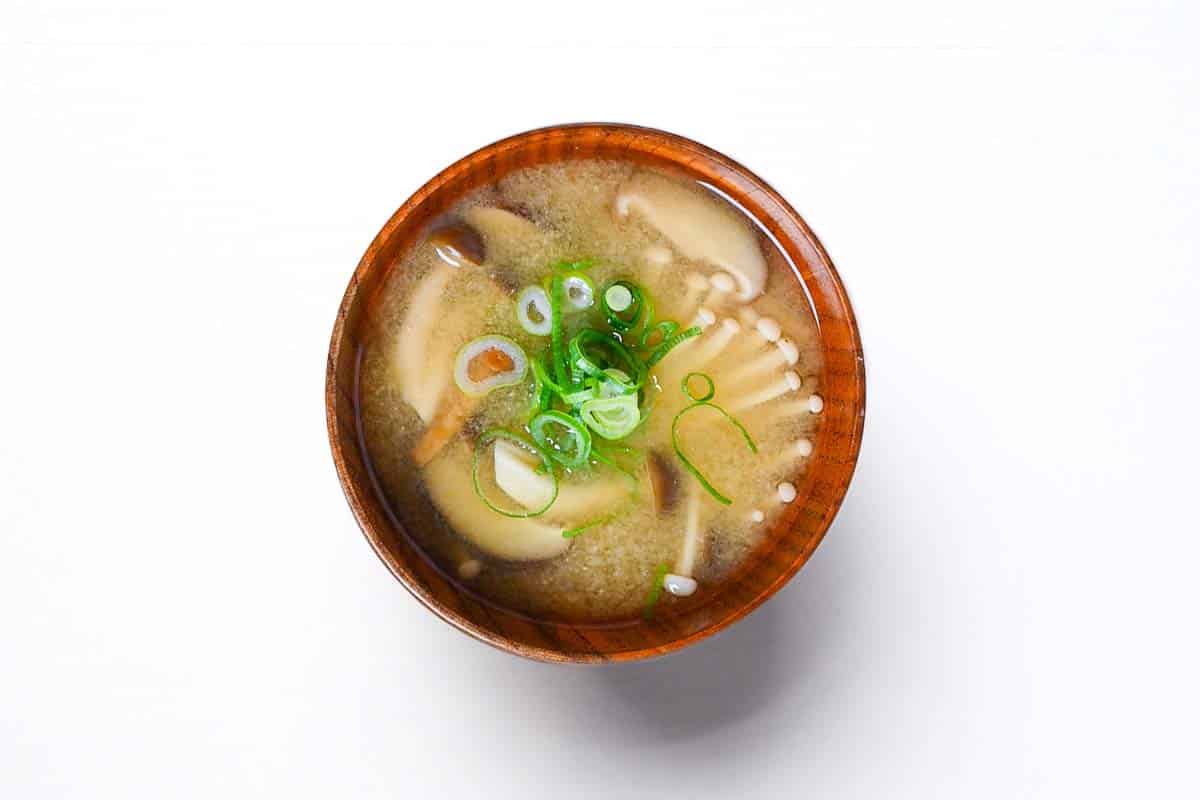

Essential Tips & Tricks
- Trim shiitake stems and slice thick mushrooms thinly so they cook evenly with smaller varieties.
- Bring dashi to just below boiling (around 90-95℃ / 194-203°F) instead of a rolling boil.
- Simmer mushrooms gently for only 3-4 minutes. Watch for softened edges and silky texture as your doneness cue.
- Always turn off the heat before adding miso.
- Dissolve miso in a mesh ladle or strainer dipped into the hot broth. This prevents stubborn lumps in the soup. If you don’t have a mesh ladle, thin out the miso by whisking it with a few tbsp of broth in a small bowl until you have a smooth and pourable consistency.
With these simple tips in mind, you’re set for success every time you make mushroom miso soup.
Storage & Meal Prep
Fridge: Store the soup (without miso added) in an airtight container for 3-4 days. If you’ve already mixed in the miso, limit storage to 1-2 days and keep in mind that some flavor will be lost.
Freezer: Not recommended once miso is added.
Meal Prep: Make a larger batch of dashi stock and refrigerate or freeze in portions. Keep prepped green onions and trimmed mushrooms in sealed containers in the fridge for up to 2 days.
Reheating: Reheat broth or soup gently on the stovetop until it reaches 74℃ (165°F), but avoid boiling once miso is in.
What to Serve With This Recipe
- Spinach Ohitashi (Soy-Dashi Dressed Spinach)
- Dashimaki Tamago (Japanese Rolled Omelet)
- Pickled Daikon and Carrot (Namasu)
- Cucumber Sunomono (Vinegar Salad)
Mushroom Miso Soup Q&A
Start with yellow (blended) miso. It’s the easiest kind to use for many dishes. You can also mix white and red (50/50) manually to make yellow.
Yes, choose certified gluten-free miso (often rice-based) and swap regular soy sauce for tamari or omit completely. Always double-check labels, since many miso pastes include barley or wheat.
Definitely! Cubed tofu, wakame seaweed, or blanched spinach are traditional additons. For proteins, there are more filling versions of miso soup made with pork (tonjiru), chicken (torijiru), clams (asari miso shiru) or even salmon miso soup.
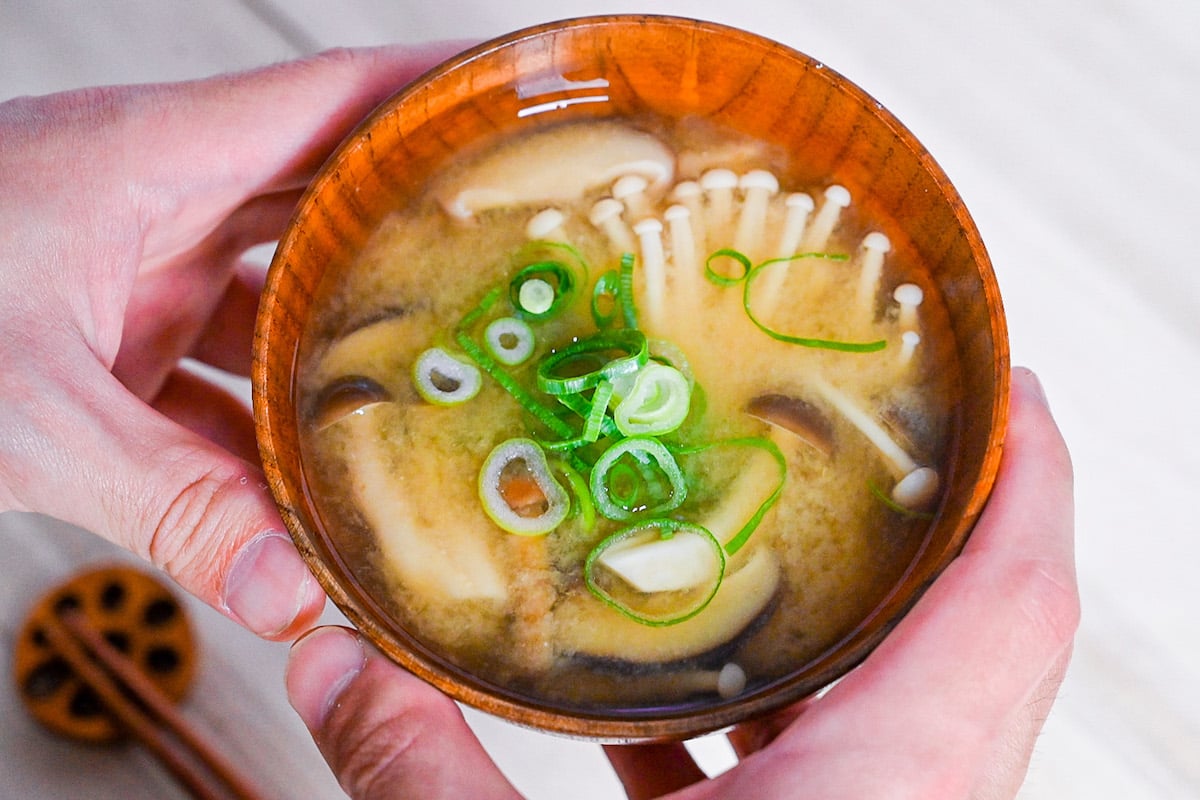
More Japanese Soup Recipes
- Japanese Clear Soup
- Kenchin Jiru (Traditional Japanese Vegetable Soup)
- Easy Chicken Zosui (Japanese Rice Soup)
- Okayu with Egg (Japanese Rice Porridge)
Hungry for more? Check out my curated selection of the best Japanese soup recipes that have become reader favorites.
Did You Try This Recipe?
I would love to hear your thoughts!
💬 Leave a review and ⭐️ rating in the comments below. 📷 I also love to see your photos – submit them here!
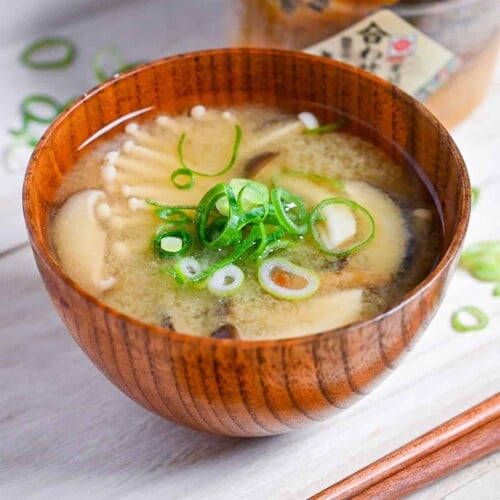
Japanese Mushroom Miso Soup
Equipment
Ingredients
- 100 g shimeji mushrooms trim base, keep small clusters
- 100 g enoki mushrooms trim base, use quickly as they spoil fast
- 75 g fresh shiitake mushroom remove stems, slice caps thin
- 50 g nameko mushrooms if unavailable, omit or replace with extra other variety
- 1 liter dashi stock to make it plant-based, use shiitake and kombu awase dashi
- ¼ tsp Japanese soy sauce (koikuchi shoyu) swap with tamari or omit for GF
- 4 tbsp yellow miso paste (awase) blend of red/white
- finely chopped green onions to garnish
My recommended brands of ingredients and seasonings can be found in my Japanese pantry guide.
Can’t find certain Japanese ingredients? See my substitution guide here.
Instructions
- Cut 75 g fresh shiitake mushroom into slices, and trim the stems/roots of the 100 g enoki mushrooms. Leave the 100 g shimeji mushrooms and 50 g nameko mushrooms whole.

- Heat 1 liter dashi stock in a pot over a medium heat.

- Once the dashi is almost boiling, add ¼ tsp Japanese soy sauce (koikuchi shoyu).

- Next, add the mushrooms and reduce the heat to a simmer. (If using additional firm mushrooms like king oyster, place them in first and cook them a bit longer.) Simmer for 3-5 minutes or until the mushrooms have softened to your liking.

- Turn off the heat, place 4 tbsp yellow miso paste (awase) on a mesh spoon, dip it in the dashi and whisk until it has broken up enough to disperse through the soup. (Avoid dropping the miso paste directly into the soup as it tends to clump together.)

- Mix thoroughly, divide into serving bowls and sprinkle with finely chopped green onions.

- Enjoy!
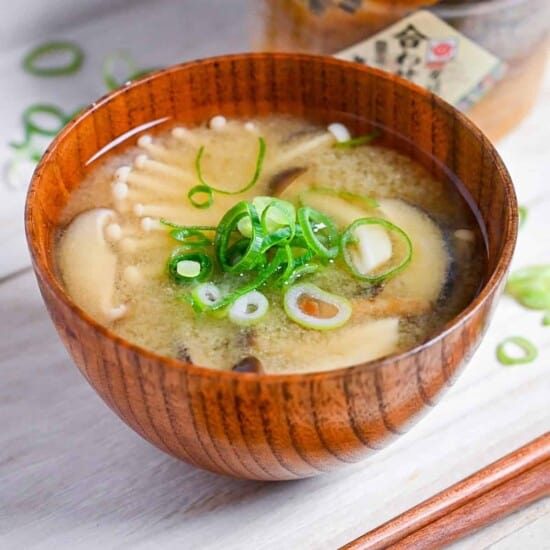





it’s soo good!
Thank you, Kim! 🙂
Mr. Omura,
Last week my wife and I went to a Japanese restaurant near us and we were served a mushroom soup that was basically dashi, button mushrooms and green onions. It was good. After being inspired by your website and recipes I made my first ever dashi and miso soup today. I used Orgnisulmte Dashi packets and Eden Shiro Miso (both from Amazon) along with sliced crimini mushrooms and green onions. I made my wife the plain dashi version like the restaurant and screened some miso in mine. Both were very simple and good, perhaps better than the restaurant version. Thank you so much for your website and instructions and inspiration! I look forward to making many more of your recipes and learning Japanese cuisine.
Hi Gaff,
Thanks for sharing your experience! It makes me so happy to hear that my recipes helped you recreate that restaurant dish at home. Hope you continue enjoying your journey into Japanese cooking! 🙂
Yuto
I made this mushroom dashi again and can’t believe how good it is. I made it the same way as the last post except I added mushrooms and white parts of onion while the dashi cooked. Much better mushroom flavor. As promised, here is a picture. Again, thanks for the inspiration.
Hi Gaff,
Thank you for your comment! I’m so happy to hear you tried this recipe again and made those delicious modifications! Love your picture – it looks amazing!
Yuto